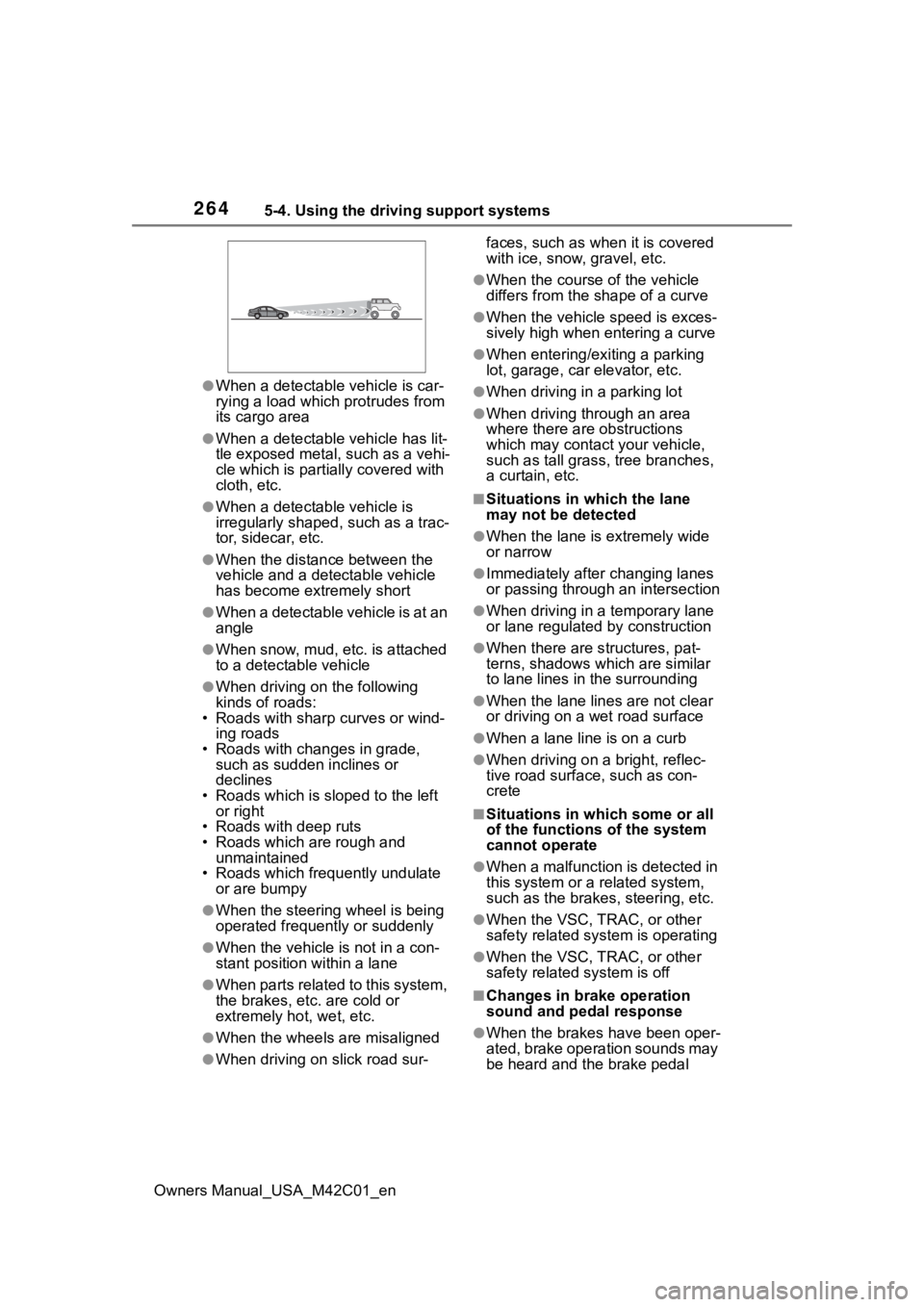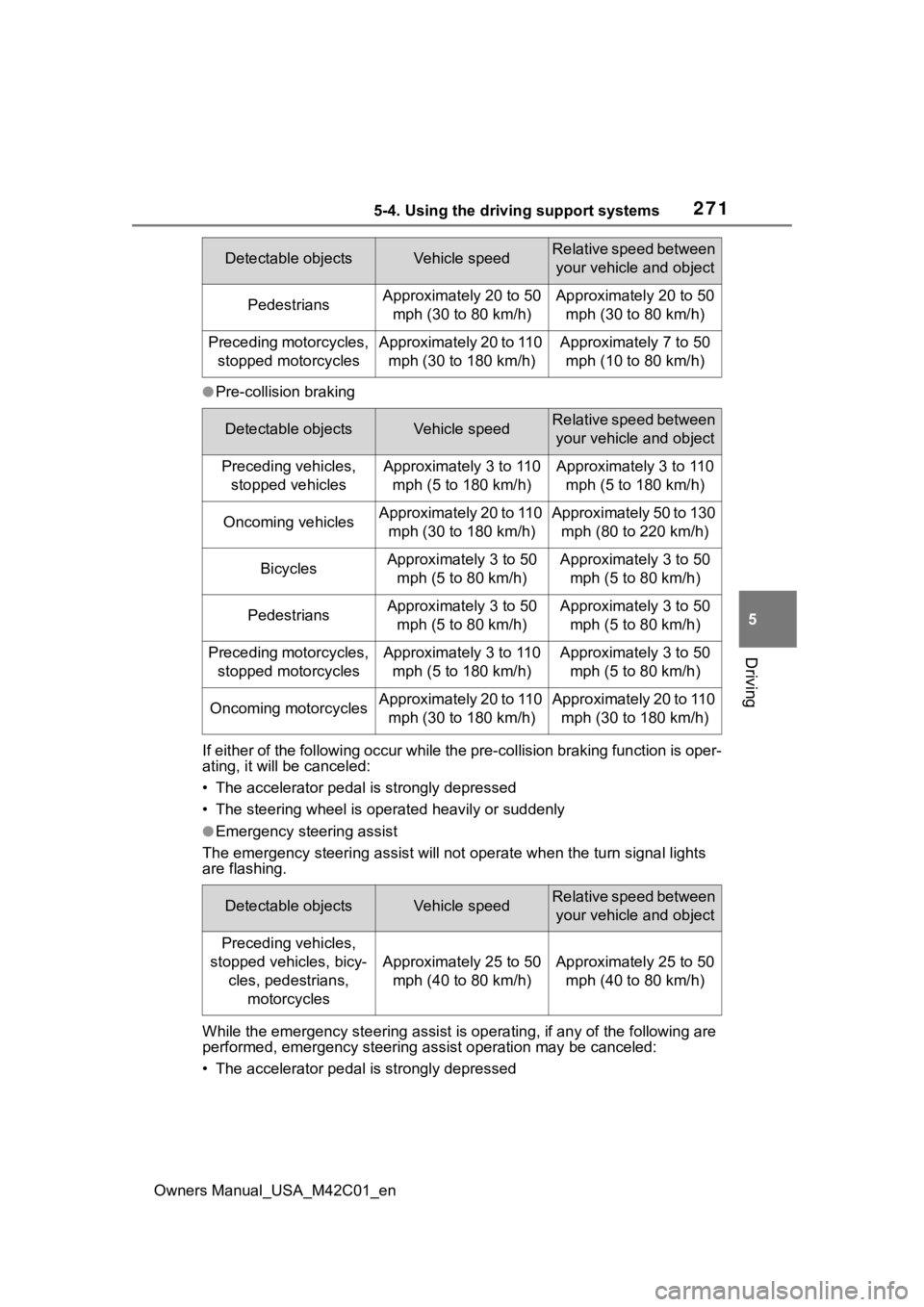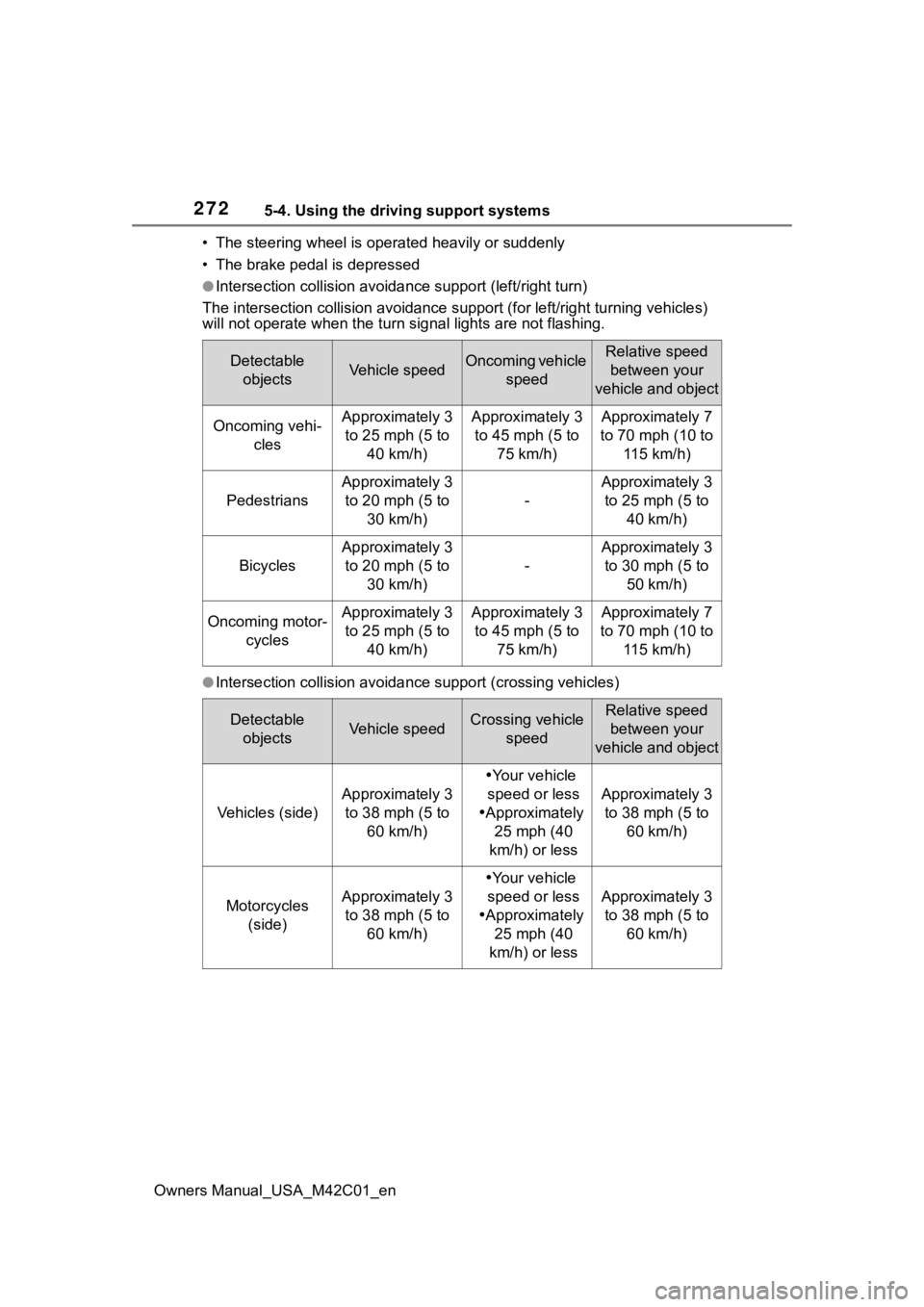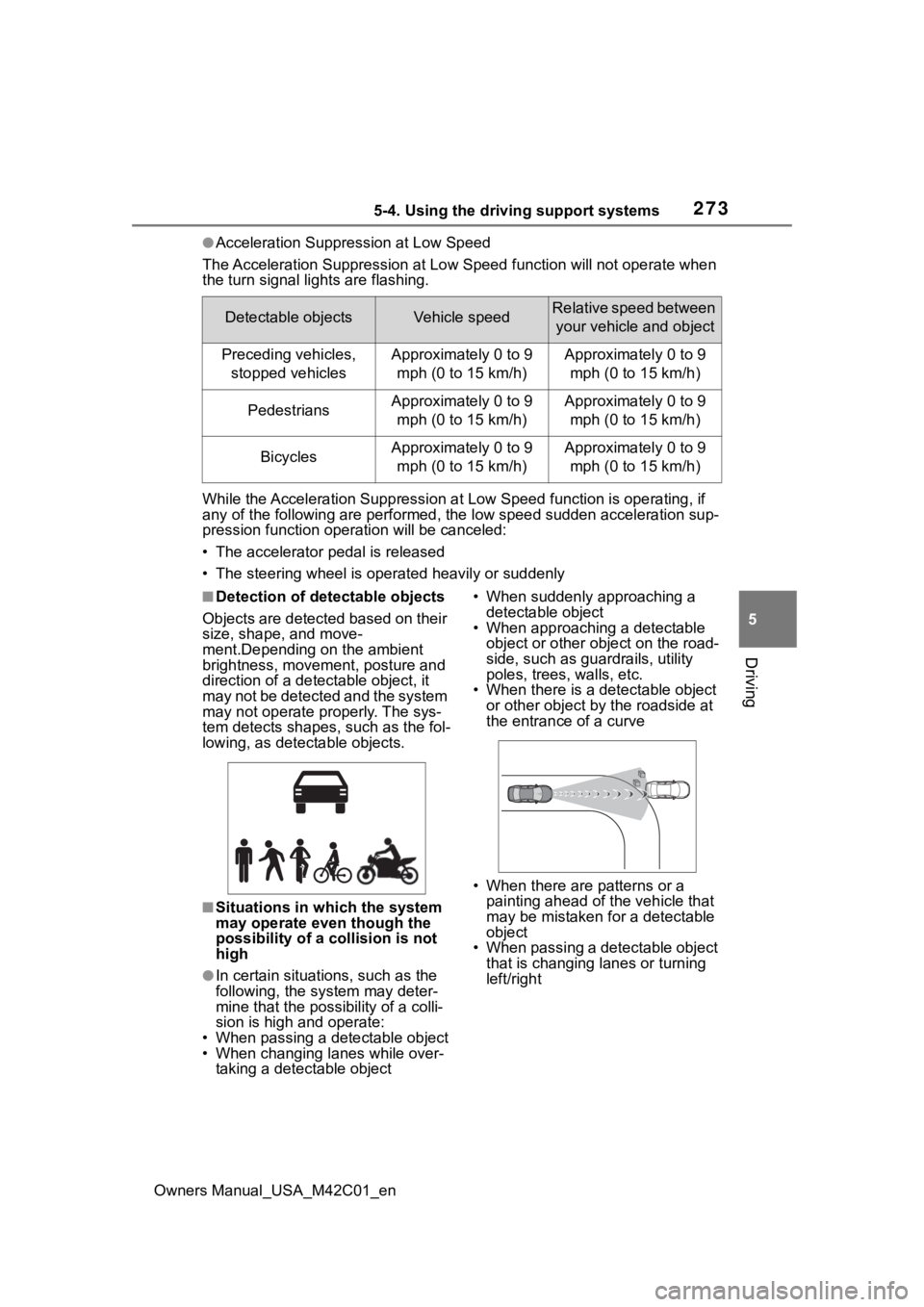2023 SUBARU SOLTERRA steering wheel
[x] Cancel search: steering wheelPage 264 of 628

2645-4. Using the driving support systems
Owners Manual_USA_M42C01_en
●When a detectable vehicle is car-
rying a load which protrudes from
its cargo area
●When a detectable vehicle has lit-
tle exposed metal, such as a vehi-
cle which is parti ally covered with
cloth, etc.
●When a detectabl e vehicle is
irregularly shaped , such as a trac-
tor, sidecar, etc.
●When the distance between the
vehicle and a detectable vehicle
has become extremely short
●When a detectable vehicle is at an
angle
●When snow, mud, etc. is attached
to a detectable vehicle
●When driving on the following
kinds of roads:
• Roads with sharp curves or wind- ing roads
• Roads with chang es in grade,
such as sudden inclines or
declines
• Roads which is slo ped to the left
or right
• Roads with deep ruts
• Roads which are rough and
unmaintained
• Roads which frequently undulate
or are bumpy
●When the steering wheel is being
operated frequently or suddenly
●When the vehicle is not in a con-
stant position within a lane
●When parts related to this system,
the brakes, etc. are cold or
extremely hot, wet, etc.
●When the wheels are misaligned
●When driving on slick road sur- faces, such as when it is covered
with ice, snow, gravel, etc.
●When the course of the vehicle
differs from the
shape of a curve
●When the vehicle speed is exces-
sively high when entering a curve
●When entering/exiting a parking
lot, garage, car elevator, etc.
●When driving in a parking lot
●When driving through an area
where there are obstructions
which may contact your vehicle,
such as tall grass , tree branches,
a curtain, etc.
■Situations in which the lane
may not be detected
●When the lane is extremely wide
or narrow
●Immediately after changing lanes
or passing through an intersection
●When driving in a temporary lane
or lane regulated by construction
●When there are s tructures, pat-
terns, shadows which are similar
to lane lines in the surrounding
●When the lane lines are not clear
or driving on a wet road surface
●When a lane line is on a curb
●When driving on a bright, reflec-
tive road surface, such as con-
crete
■Situations in which some or all
of the functions of the system
cannot operate
●When a malfunction is detected in
this system or a related system,
such as the brakes, steering, etc.
●When the VSC, TRAC, or other
safety related system is operating
●When the VSC, TRAC, or other
safety related system is off
■Changes in brake operation
sound and pedal response
●When the brakes have been oper-
ated, brake operation sounds may
be heard and the brake pedal
Page 267 of 628

2675-4. Using the driving support systems
Owners Manual_USA_M42C01_en
5
Driving
“Accelerator Pedal is
Pressed”
■Pre-collision brake assist
If the system determines that
the possibility of a collision is
high and the brake operation by
the driver is insufficient, the
braking power will be increased.
■Pre-collision brake control
If the system determines that
the possibility of a collision is
extremely high, the brakes are
automatically applied to help
avoid the collision or reduce the
impact of the collision.
■Emergency steering assist
If the system determines that
the following conditions are met,
assistance will be provided to
help enhance vehicle stability
and prevent lane departure.
During assistance, in addition to
the pre-collision warning, the fol-
lowing icon will be displayed on
the multi-information display.
The possibility of a collision is
high
There is sufficient space
within the lane to perform
evasive steering maneuvers
The driver is operating the
steering wheel
During assistance, the pre-colli-
sion warning will operate and a
message will be displayed to
warn the driver.
■Intersection collision avoid-
ance support (left/right
turn)
In situations such as the follow-
ing, if the system determines
that the possibility of a collision
is high, the pre-collision warning
and pre-collision braking will
operate. Depending on the inter-
section, assistance may not
operate correctly.
When turning left/right at an
intersection and crossing the
path of an oncoming vehicle
When turning left/right and an
oncoming pedestrian or bicy-
cle is detected
Page 268 of 628

2685-4. Using the driving support systems
Owners Manual_USA_M42C01_en
■Intersection collision avoid-
ance support (crossing
vehicles)
At an intersection, etc., if the
system determines that the pos-
sibility of a collision with an
approaching vehicle or motorcy-
cle is high, the pre-collision
warning and pre-collision brak-
ing will operate. Depending on
the intersection, assistance may
not operate correctly.
■Acceleration Suppression
at Low Speed
When driving at a low speed, if
the accelerator pedal is strongly
depressed and the system
determines that there is a possi-
bility of a collision, EV system
output will be restrained or the
brakes will be applied weakly to
restrict acceleration. During operation, a buzzer will sound
and a warning indicator and
message will be displayed on
the multi-information display.
“Accelerator Pedal is
Pressed”
WARNING
■Pre-collision braking
●When the pre-collision braking
function is operating, a large
amount of braking force will be
applied.
●Pre-collision braking function is
not intended for remain
stopped. If the vehicle is
stopped by pre-collision brak-
ing function, the driver should
operate the brakes as neces-
sary.
●The pre-collision braking func-
tion may not operate if certain
operations are performed by the
driver. If the accelerator pedal is
being depressed strongly or the
steering wheel is being turned,
the system may determine that
the driver is taking evasive
action and possibly prevent the
pre-collision braking function
from operating.
Page 269 of 628

2695-4. Using the driving support systems
Owners Manual_USA_M42C01_en
5
Driving
WARNING
●If the brake pedal is being
depressed, the system may
determine that the driver is tak-
ing evasive action and possibly
delay the operation timing of the
pre-collision brake control.
■Acceleration Suppression at
Low Speed
If the steering wheel is being
turned, the syste m may determine
that the driver is taking evasive
action and possibly prevent the
Acceleration Suppression at Low
Speed function from operating.
■Emergency steering assist
●The emergency steering assist
will be canceled when the sys-
tem determines that lane depar-
ture prevention control has
completed.
●Depending on operations per-
formed by the driver, emer-
gency steering assist may not
operate or operation may be
canceled.
• If the accelerator pedal is depressed strongly, the steering
wheel is turned heavily, the
brake pedal is depressed, or the
turn signal lever is operated, the
system may determine that the
driver is taking evasive action
and the emergency steering
assist may not operate.
• While the emergency steering assist is operating, if the accel-
erator pedal is depressed
strongly, the st eering wheel is
turned heavily, or the brake
pedal is depressed, the system
may determine that the driver is
taking evasive action and emer-
gency steering assist operation
may be canceled.
• While the emergency steering assist is operating, if the steer-
ing wheel is held or turned in the
opposite direction of system
operation, emergency steering
assist operation will be can-
celed.
Page 271 of 628

2715-4. Using the driving support systems
Owners Manual_USA_M42C01_en
5
Driving
●Pre-collisio n braking
If either of the following occur while the pre-collision braking function is oper-
ating, it will be canceled:
• The accelerator pedal is strongly depressed
• The steering wheel is ope rated heavily or suddenly
●Emergency steering assist
The emergency steeri ng assist will not opera te when the turn signal lights
are flashing.
While the emergency ste ering assist is operating, if any of the following are
performed, emergency steering assi st operation may be canceled:
• The accelerator pedal is strongly depressed
PedestriansApproximately 20 to 50 mph (30 to 80 km/h)Approximately 20 to 50 mph (30 to 80 km/h)
Preceding motorcycles, stopped motorcyclesApproximately 20 to 110 mph (30 to 180 km/h)Approximately 7 to 50 mph (10 to 80 km/h)
Detectable objectsVehicle speedRelative speed between your vehicle and object
Preceding vehicles, stopped vehiclesApproximately 3 to 110 mph (5 to 180 km/h)Approximately 3 to 110 mph (5 to 180 km/h)
Oncoming vehiclesApproximately 20 to 110 mph (30 to 180 km/h)Approximately 50 to 130 mph (80 to 220 km/h)
BicyclesApproximately 3 to 50 mph (5 to 80 km/h)Approximately 3 to 50 mph (5 to 80 km/h)
PedestriansApproximately 3 to 50 mph (5 to 80 km/h)Approximately 3 to 50 mph (5 to 80 km/h)
Preceding motorcycles, stopped motorcyclesApproximately 3 to 110 mph (5 to 180 km/h)Approximately 3 to 50 mph (5 to 80 km/h)
Oncoming motorcyclesApproximately 20 to 110 mph (30 to 180 km/h)Approximately 20 to 110 mph (30 to 180 km/h)
Detectable objectsVehicle speedRelative speed between your vehicle and object
Preceding vehicles,
stopped vehicles, bicy- cles, pedestrians, motorcycles
Approximately 25 to 50 mph (40 to 80 km/h)Approximately 25 to 50 mph (40 to 80 km/h)
Detectable objectsVehicle speedRelative speed between your vehicle and object
Page 272 of 628

2725-4. Using the driving support systems
Owners Manual_USA_M42C01_en• The steering wheel is ope
rated heavily or suddenly
• The brake pedal is depressed
●Intersection collisio n avoidance support (left/right turn)
The intersection collision avoida nce support (for left/right turning vehicles)
will not operate when the turn signal light s are not flashing.
●Intersection collision avoidance support (crossing vehicles)
Detectable
objectsVehicle speedOncoming vehicle speedRelative speed between your
vehicle and object
Oncoming vehi- clesApproximately 3 to 25 mph (5 to 40 km/h)Approximately 3 to 45 mph (5 to 75 km/h)Approximately 7
to 70 mph (10 to 115 km/h)
Pedestrians
Approximately 3 to 20 mph (5 to 30 km/h)
-
Approximately 3 to 25 mph (5 to 40 km/h)
Bicycles
Approximately 3 to 20 mph (5 to 30 km/h)
-
Approximately 3 to 30 mph (5 to 50 km/h)
Oncoming motor- cyclesApproximately 3 to 25 mph (5 to 40 km/h)Approximately 3 to 45 mph (5 to 75 km/h)Approximately 7
to 70 mph (10 to 115 km/h)
Detectable objectsVehicle speedCrossing vehicle speedRelative speed between your
vehicle and object
Vehicles (side)
Approximately 3 to 38 mph (5 to 60 km/h)
Your vehicle
speed or less
Approximately
25 mph (40
km/h) or less
Approximately 3 to 38 mph (5 to 60 km/h)
Motorcycles (side)Approximately 3 to 38 mph (5 to 60 km/h)
Your vehicle
speed or less
Approximately
25 mph (40
km/h) or less
Approximately 3 to 38 mph (5 to 60 km/h)
Page 273 of 628

2735-4. Using the driving support systems
Owners Manual_USA_M42C01_en
5
Driving
●Acceleration Suppression at Low Speed
The Acceleration Suppression at Low Speed function will not ope rate when
the turn signal lig hts are flashing.
While the Acceleration Suppression at Low Speed function is ope rating, if
any of the following are performed, the low speed sudden acceleration sup-
pression function oper ation will be canceled:
• The accelerator pedal is released
• The steering wheel is ope rated heavily or suddenly
■Detection of detectable objects
Objects are detected based on their
size, shape, and move-
ment.Depending on the ambient
brightness, movement, posture and
direction of a det ectable object, it
may not be detected and the system
may not operate properly. The sys-
tem detects shapes, such as the fol-
lowing, as detectable objects.
■Situations in which the system
may operate even though the
possibility of a co llision is not
high
●In certain situations, such as the
following, the sys tem may deter-
mine that the possibility of a colli-
sion is high and operate:
• When passing a detectable object
• When changing lanes while over-
taking a detectable object • When suddenly approaching a
detectable object
• When approaching a detectable
object or other ob ject on the road-
side, such as guardrails, utility
poles, trees, walls, etc.
• When there is a d etectable object
or other object by the roadside at
the entrance of a curve
• When there are patterns or a painting ahead of the vehicle that
may be mistaken for a detectable
object
• When passing a detectable object that is changing lanes or turning
left/right
Detectable objectsVehicle speedRelative speed between
your vehicle and object
Preceding vehicles, stopped vehiclesApproximately 0 to 9 mph (0 to 15 km/h)Approximately 0 to 9 mph (0 to 15 km/h)
PedestriansApproximately 0 to 9 mph (0 to 15 km/h)Approximately 0 to 9 mph (0 to 15 km/h)
BicyclesApproximately 0 to 9 mph (0 to 15 km/h)Approximately 0 to 9 mph (0 to 15 km/h)
Page 274 of 628

2745-4. Using the driving support systems
Owners Manual_USA_M42C01_en• When passing a detectable object
which is stopped to make a
left/right turn
• When a detectable object stops immediately before entering the
path of the vehicle
• When passing through a location with a structure above the road
(traffic sign, b illboard, etc.)
• When approaching an electric toll gate barrier, parking lot barrier, or
other barrier that opens and
closes
• When turning left/right and an oncoming vehicle or pedestrian
crosses in front of the vehicle
• When attempting to turn left/right in front of an oncoming vehicle or
pedestrian
• When turning left/right and an oncoming vehicle or pedestrian
stops immediately before entering
the path of the vehicle
• When turning left/right and an oncoming vehicle turns left/right in
front of the vehicle • When the steering wheel is oper-
ated toward the path of an oncom-
ing vehicle
■Situations in which the system
may not operate properly
●In certain situations, such as the
following, a detectable object may
not be detected by the front sen-
sors, and the system may not
operate properly:
• When a detectable object is approaching your vehicle
• When your vehicle or a detectable object is wandering
• When a detectable object makes
an abrupt maneuver (such as sud-
den swerving, acceleration or
deceleration)
• When suddenly approaching a detectable object
• When the detectable object is
near a wall, fence, guardrail, man-
hole cover, steel plate on the road
surface, or another vehicle
• When there is a structure above a detectable object
• When part of a detectable object
is hidden by another object (large
luggage, umbrella, guardrail, etc.)
• When multiple det ectable objects
are overlapping
• When a bright light, such as the sun, is reflecting off of a detect-
able object
• When a detectable object is white and looks extremely bright
• When the color or brightness of a detectable object causes it to
blend in with its surroundings
• When a detectable object cuts in
front of or suddenly emerges in
front of your vehicle
• When approaching a vehicle
which is diagonal